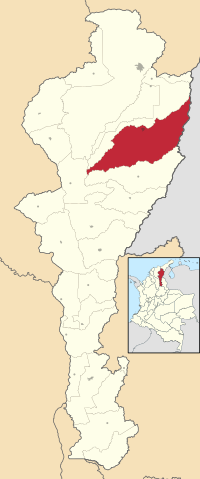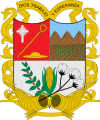Agustín Codazzi, Cesar facts for kids
Quick facts for kids
Agustín Codazzi
|
|||
|---|---|---|---|
|
Municipality and town
|
|||
|
|||

Location of the municipality and town of Agustin Codazzi in the Department of Cesar.
|
|||
| Country | |||
| Region | Caribbean | ||
| Department | Cesar | ||
| Founded | 1700 | ||
| Founded by | Salvador Félix Arias | ||
| Area | |||
| • Municipality and town | 1,739 km2 (671 sq mi) | ||
| • Urban | 11.74 km2 (4.53 sq mi) | ||
| Elevation | 131 m (430 ft) | ||
| Population
(2018 census)
|
|||
| • Municipality and town | 60,768 | ||
| • Density | 34.944/km2 (90.505/sq mi) | ||
| • Urban | 48,157 | ||
| • Urban density | 4,102.0/km2 (10,624/sq mi) | ||
| Time zone | UTC-5 | ||
Agustín Codazzi, often called Codazzi, is a city and municipality in the Department of Cesar in Colombia. It was started in 1784 by a Spanish Captain named Salvador Felix de Arias. He first called it El Pueblito del Espiritu Santo.
Later, the town was renamed after Giovanni Battista Agostino Codazzi. He was an Italian cartographer (mapmaker) who passed away there in 1859. The city is located near the Serranía del Perijá mountains, in the valley of the Cesar River.
In 1958, Codazzi became a municipality. This happened because its population grew very quickly in the 1950s and 1960s. Many people moved there for jobs when cotton farming became very popular. They came from different parts of Colombia, like Tolima, Huila, and Santander.
After the cotton boom ended, the area started growing other crops. These included palm, sugar cane, and making milk products. In 2005, about 52,219 people lived in Codazzi. By 2018, the population was around 60,768.
Contents
City Symbols
Coat of Arms
The coat of arms (city emblem) of Codazzi has four parts.
- The top left part shows a picture related to the religious festivals of the divine shepherdess.
- The top right part shows the Perijá mountains.
- The bottom part displays fruits and farm products like coffee, corn, and cotton.
- It also shows bows and arrows. These remind us of the Yukpa tribe, who lived in this area long ago.
Flag
The flag of Codazzi has two colors: white and green.
- The green represents the tall Perijá mountains.
- The white stands for the important cotton farming in the area.
Other Important Symbols
Cotton is a very important symbol for Codazzi. The city was even called the "white city of Colombia" because of it. Between 1958 and 1975, Codazzi was the main cotton producer in Colombia.
In 1960, Codazzi planted 20,980 hectares (51,800 acres) of cotton. This made it the top cotton producer in the country. By 1975, the planted area reached 60,000 ha (150,000 acres). However, cotton farming later decreased quickly.
City History
This town was first called "Holy Spirit" around 1700. Captain Salvador Felix Arias, who was the governor of Province of Santa Marta, founded it. He used land that was given for this purpose. (Some say Captain Felix Torres founded it in 1784).
Local tribes from the Serranía del Perijá mountains claimed these lands. This forced Captain Salvador Arias to leave.
The town became a municipality in 1958. This happened when it separated from the municipality of Robles. A priest named Leandro Maria Algezares suggested naming it Agustín Codazzi. This was to honor the Italian military officer and geographer.
The creation of the municipality of Codazzi was officially approved. This happened through a decree from the Government of the Department of Magdalena on February 25, 1958.
About Agostino Codazzi
Agostino Codazzi was born on July 12, 1793, in Lugo, Italy. His parents were Domingo Codazzi and Bartolotti Constance.
From 1850 to 1859, Codazzi traveled through what is now Colombia. He was part of the Commission Corográfica. This group of geographers and naturalists was tasked with mapping the country. Sadly, he got malaria and passed away on February 7, 1859. He died in the town of Holy Spirit, which is now called Codazzi in his honor.
Geography
Where is Codazzi?
The municipality of Agustín Codazzi is in the northern part of Cesar. It is about 1 hour (45 kilometres or 28 miles) from the capital city, Valledupar. The municipality includes four districts, 23 villages, and 42 smaller areas. The area has different climates because part of it is in the Perijá mountains.
Climate
The weather in Codazzi is generally warm because it is in a tropical area. Temperatures are usually high, and they don't change much throughout the year. However, temperatures can vary depending on how high up in the mountains you are.
The municipality has two rainy seasons and two dry seasons each year. The average temperature is around 29.5 °C (85.1 °F). Temperatures can range from 4 and 34 °C (39 and 93 °F). The hottest month is July, with an average of 31 °C (88 °F). The coolest months are December and January, averaging 22 °C (72 °F). Hailstorms can happen during the rainy months, especially from September to January.
| Climate data for Agustín Codazzi (Motilonia Codazzi), elevation 180 m (590 ft), (1981–2010) | |||||||||||||
|---|---|---|---|---|---|---|---|---|---|---|---|---|---|
| Month | Jan | Feb | Mar | Apr | May | Jun | Jul | Aug | Sep | Oct | Nov | Dec | Year |
| Mean daily maximum °C (°F) | 35.7 (96.3) |
36.3 (97.3) |
36.0 (96.8) |
35.1 (95.2) |
33.5 (92.3) |
33.8 (92.8) |
34.6 (94.3) |
34.3 (93.7) |
33.1 (91.6) |
32.5 (90.5) |
32.8 (91.0) |
34.1 (93.4) |
34.3 (93.7) |
| Daily mean °C (°F) | 29.5 (85.1) |
30.2 (86.4) |
30.3 (86.5) |
29.6 (85.3) |
28.6 (83.5) |
28.6 (83.5) |
29.1 (84.4) |
28.8 (83.8) |
28.0 (82.4) |
27.5 (81.5) |
27.7 (81.9) |
28.2 (82.8) |
28.8 (83.8) |
| Mean daily minimum °C (°F) | 22.3 (72.1) |
23.4 (74.1) |
24.0 (75.2) |
24.6 (76.3) |
24.4 (75.9) |
24.2 (75.6) |
23.9 (75.0) |
24.0 (75.2) |
23.8 (74.8) |
23.7 (74.7) |
23.4 (74.1) |
22.5 (72.5) |
23.7 (74.7) |
| Average precipitation mm (inches) | 22.6 (0.89) |
36.5 (1.44) |
80.1 (3.15) |
149.7 (5.89) |
207.0 (8.15) |
149.2 (5.87) |
111.7 (4.40) |
153.9 (6.06) |
193.2 (7.61) |
258.9 (10.19) |
171.9 (6.77) |
63.2 (2.49) |
1,597.9 (62.91) |
| Average precipitation days | 2 | 3 | 6 | 11 | 16 | 13 | 12 | 16 | 17 | 17 | 13 | 4 | 129 |
| Average relative humidity (%) | 61 | 60 | 63 | 70 | 76 | 75 | 72 | 73 | 77 | 80 | 78 | 69 | 71 |
| Mean monthly sunshine hours | 282.1 | 234.3 | 226.3 | 189.0 | 179.8 | 183.0 | 204.6 | 201.5 | 177.0 | 186.0 | 207.0 | 248.0 | 2,518.6 |
| Mean daily sunshine hours | 9.1 | 8.3 | 7.3 | 6.3 | 5.8 | 6.1 | 6.6 | 6.5 | 5.9 | 6.0 | 6.9 | 8.0 | 6.9 |
| Source: Instituto de Hidrologia Meteorologia y Estudios Ambientales | |||||||||||||
City Limits
Codazzi borders other municipalities:
- To the north: La Paz and San Diego.
- To the south: Becerril.
- To the west: El Paso.
- To the east: The Serranía del Perijá mountains. These mountains form a natural limit between Colombia and Venezuela.
Economy
Codazzi was once known as the "white city of Colombia" because it was a top producer during the cotton era.
Today, Codazzi is becoming a major center for agriculture and energy in Colombia.
- It has the first biodiesel plant in Colombia.
- It is planning a plant to make Alcohol fuel from cassava.
- The area is part of a very large coal project called "The Rest." This project will allow the "Drummond" company to produce 50 million tons of coal each year.
Codazzi also has strong farming and livestock industries.
- It is the top coffee producer in the Caribbean Region of Colombia, with over 5,700 ha (14,000 acres) planted.
- It is the second-largest city in Cesar for raising cattle, with over 132,000 heads.
- The Perijá mountains offer great potential for growing fruits.
Tourism
The Magiriaimo River is a beautiful natural attraction in Codazzi. Its surroundings are home to many different plants and animals.
The city also hosts popular events:
- The Vallenato festival, featuring music played on guitars.
- A livestock fair.
These festivals attract many visitors, especially from nearby Valledupar. They are usually held in August and November. During these times, hotels in Codazzi can be completely full.
In the future, an "ECO-PARK" is planned for the Perijá mountains. This park will help protect the plants, animals, and water sources there. It is also expected to attract many nature tourists. With the growth of coal and agro-energy industries, the hotel business in Codazzi is expected to grow too.
Vallenato Music Festival on Guitar
The main cultural event in Agustín Codazzi is the Festival Vallenato Music on Guitar. It started in 1987 and celebrates traditional music played by trios, and features merengue music. This festival has been held for over 27 years, usually in mid-August. The city also celebrates the "Virgin Divina Pastora" festivities.
The Ministry of Culture lists this festival as one of the 17 most important traditional music festivals in Colombia. It was the first festival of its kind in the country.
This event is very popular with national guitarists and composers. More and more people participate each year. This has also led to more interest from the media in covering and sharing the event.
Twin Cities
See also
 In Spanish: Agustín Codazzi (Cesar) para niños
In Spanish: Agustín Codazzi (Cesar) para niños




